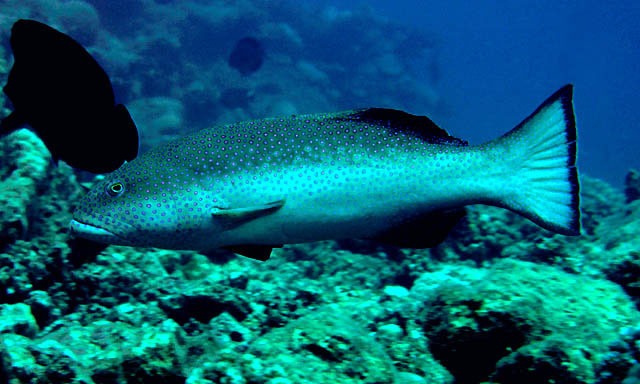| Serranidae (Sea basses: groupers and fairy basslets), subfamily: Epinephelinae |
| 80 cm TL (male/unsexed) |
|
reef-associated; depth range 1 - 20 m |
| Indo-Pacific: Red Sea to the Phoenix Islands and Samoa, north to Ryukyu Islands, south to Australia. |
|
Dorsal spines (total): 7-8; Dorsal soft rays (total): 10-12; Anal spines: 3-3; Anal soft rays: 8-8. Distinguished by the following characteristics: Has truncate tail with a narrow white posterior margin (Ref. 37816); further characterized by whitish to pale grey color; head, body and fins with numerous small, dark-edged blue spots; frequently with 4-5 dark blotches forming saddles on back; large canine teeth at front of jaws; 1-4 large canines on side of lower jaw; elongate body, greatest depth 2.9-3.9 in SL; truncate to slightly emarginate caudal fin; pectoral fins 2.0-2.3 in head length; pelvic fins 2.0-2.4 in head length (Ref. 90102); snout length 2.8-3.6 times in head length; suborbital depth 5.6-10 times in HL; flat interorbital area, with small, embedded scales; broadly rounded preopercle, with 3 large , ventrally directed spines along lower half; smooth interopercle and subopercle; 3 flat spines on opercle, upper and lower spines covered by skin; posterior and anterior nostrils subequal in size, set in shallow groove running forward from eye (Ref. 89707). |
| Adults inhabit lagoon and seaward reefs, in areas with rich coral growth. Most frequently encountered in channels along the reef front (Ref. 9710, 48635). Often a shy fish (Ref. 48635). Feed exclusively on fishes (Ref. 37816). Misidentified as P. leopardus in Ref. 2928 (Johannes, pers. comm.). This study reports of a declining stock in Palau due to fishing. Before actual spawning around full moon, the species aggregates along channels and are responsive to baited hooks, making them vulnerable to fishermen; upward movements of some to take baited hooks presumably mistaken for courtship or spawning behavior. Large individuals may be ciguatoxic in certain areas (Ref. 37816). In the Hong Kong live fish markets (Ref. 27253). |
|
Vulnerable (A4d)
(Ref. 96402)
|
| reports of ciguatera poisoning |
|
Source and more info: www.fishbase.org. For personal, classroom, and other internal use only. Not for publication.
Page created by Jen, 05.08.02,
php script by kbanasihan 06/09/2010 ,
last modified by
dsantos, 20/08/10

